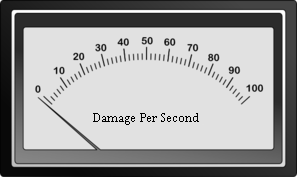Mistrealm
Dungeons and Dragons
DPS

DPS (average rate of damage inflicted over time) is a critical component to many gamers, being a measure of how much they contribute to combat. Many factors contribute to DPS. Combat is chaotic and complex, and in D&D, the character creation rules are even more complex. At times it can be very difficult to determine the optimal choice.
This effort is inspired by the Making Monsters article in Monster Manual I (v3.5)(page 302):
The best way to set a monsterís CR is to see how it handles in play. This can be time-consuming, but it probably gives you the best information about how challenging your monster is.And also (from http://www.wizards.com/default.asp?x=dnd/dd/20070803a):
A typical monster has a lifespan of five rounds. That means it basically does five things, ever, period, the end.The suggested playtest procedure is to
Create a "playtest party" consisting of four characters whose level equals your monsterís target CR + 2. Each character should be built using the standard ability score array and equipment for a PC of their level. Include a fighter, rogue, cleric, and wizard if possible.That is actually a lot of work, especially at higher levels. In theory, I can use Tables 4-12 through 4-22 from the DMG (3.5, p112-p126) to make this easier. (Sorry, was not able to find the d20 versions of these tables. If you know where one is, let me know and I will link it here).
